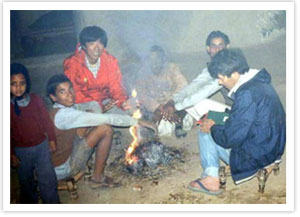Geography
| Lecturer | Tsunetoshi MIZOGUCHI, Professor |
|---|---|
| Department | Institute of Liberal Arts & Sciences, 2011 Fall |
| Recommended for: | Liberal arts students (2・1 session / week 15 weeks / semester) |

Theme
India-market -field work
Key Features
I do not adopt the conventional style of lectures in which a teacher reads a textbook and explains about it. Instead, in my lectures I deal with records, pictures and videos which were taken when I visited South Asian countries a few dozen times in the quarter of a century after 1977. Especially focusing on how young people who are the same generation as students taking this course live in these countries, I will try to demonstrate two sides to the caste society of South Asia vividly. I will not make lectures one-way from me to students but I will invite questions from students in every lecture. In addition, during the term, I will provide chances twice for students to make questions on a sheet of A4 paper and then I will answer them the next week.
Course Aims
In this lecture, the course of geography for freshmen, I will take them to South Asia at first. In Asian countries which seem to near from Japan but far away, South Asian countries (India, Bangladesh, Nepal) are alien in terms of everything such as climate, race, language and social systems. There are more and more international students from these countries in Nagoya University and therefore now we have chance to see them in the university. On the other hand, although many students of Nagoya University go to study to Europe, the United States, China, Korea and Southeast countries in Asia, they rarely go to South Asia. The aim of this course is under such situations, I would like students to know and get interested in South Asia.
Basic attitude of the author to the study of South Asia
The author demonstrate that people in South Asian society in which Hindu and Muslim are intermingled get along with each other on the level of daily life though they disagree at times.
The specialty of the author is the regional history of pre-modern and contemporary Japan, however, he aims to establish cross-regional environmental history beyond time and space by conducting fieldwork on contemporary South Asia.
Related subjects
Geography and General lectures related with South Asia
Reference books
Tsunetoshi Mizoguchi, "India, Market, fieldwork", Nakanisiya shoten, January 2006
Jun Ishihara and Tsunetoshi Mizoguchi, "Periodic Market in South Asia - a traditional circulation system", Kokon shoin, Septermber 2006
Course Schedule
| Session | Contents |
|---|---|
| 1 | Guidance |
| 2 | Climate of India |
| 3 | Caste system |
| 4 | Cuisine |
| 5 | Marriage |
| 6 | Cremation |
| 7 | People of various castes |
| 8 | Hinduism and Islam |
| 9 | Hindu gods
Mid-term examination |
| 10 | Periodic markets |
| 11 | Merchant of aluminum dishes |
| 12 | Floods in Bangladesh |
| 13 | Passers-by of the mountainous lands in Nepal |
| 14 | Development and assistance |
| 15 | Summary / Final examination |
Lecture Handouts
Note: All documents are in Japanese.
Session 1
Session 2
Session 3
Session 4
Session 5
Session 6
Session 7
Session 8
Session 9
Session 10
Session 11
Session 12
Session 13
Session 14
Assignment
Note: All documents are in Japanese.
Question of mid-term examination
Grading
Mid-term examination (30%)
Final examination (70%)
Reference Resources
Reference book 1:Tsunetoshi Mizoguchi, "India, Market, fieldwork", Nakanishiya shoten, January 2006
The book which has the same title as this course was published by Nakanishiya publisher on 1st January 2006 and it was nominated as one of reference readings of library. It contains the diary which was written when the author visited all of periodic markets (30 places) in Sandila in North India. This book is composed of eight chapters: 1) go to the country of sari, 2) Lodhaura, 3) fair, 4) camel anniversary, 5) cremation, 6) market of the king and village of prostitutes, 7) farewell, 8) reunion. It also contains other eight chapters as commentary: 1) caste system, 2) villages in North India, 3) periodic markets, 4) Hinduism and Islam, 5) marriage of Hindu, 6) the climate of India, 7) cuisine of caste society, 8) the other side of street performances. It also contains diaries of the students who visited India as the first trip for overseas.
Reference book 2:Jun Ishihara and Tsunetoshi Mizoguchi, "Periodic Market in South Asia - a traditional circulation system", Kokon shoin, Septermber 2006
In South Asian countries such as India, many people still live in rural villages. In these villages, traditional periodic markets even now play an important role as a place to exchange products and services. This book demonstrates the current status and transformation of caste system focusing on people getting together at periodic markets. The author visited about 30 periodic markets each in Bangladesh, West Bengal, North India, South India from 1984 to 1989, made a market map and investigate sellers and buyers. This book is a research report of those investigations.
Since the methods of investigation are unified in four areas, we can compare periodic markets in India with those in Bangladesh. Of those, reference book 1 is inside story of the investigation in North India.
Environment of South Asia and Pictures of fieldwork: lecture notes
Last updated
May 15, 2020
